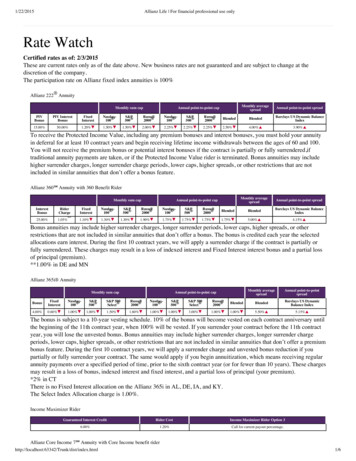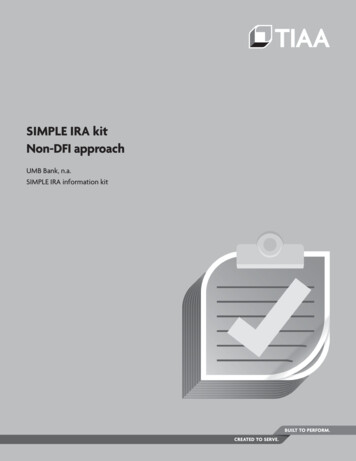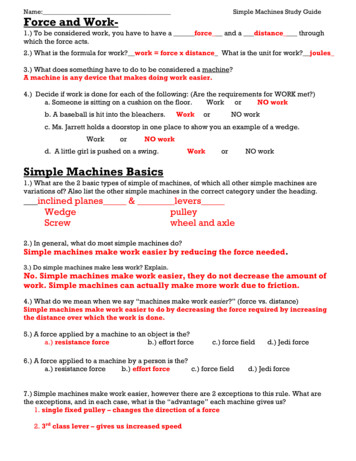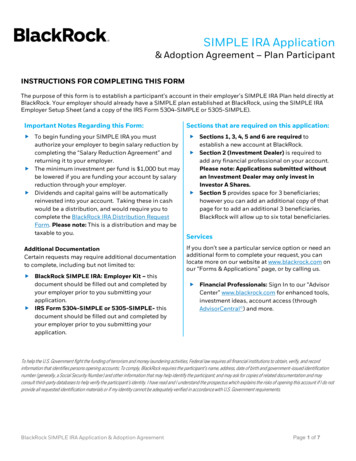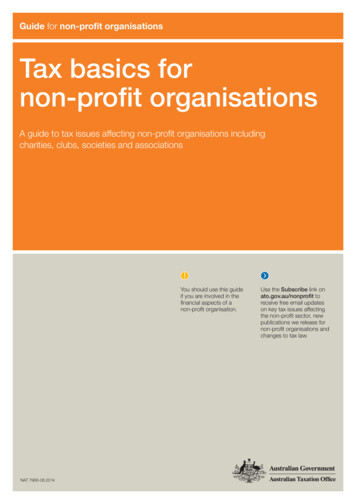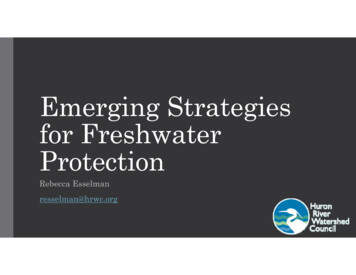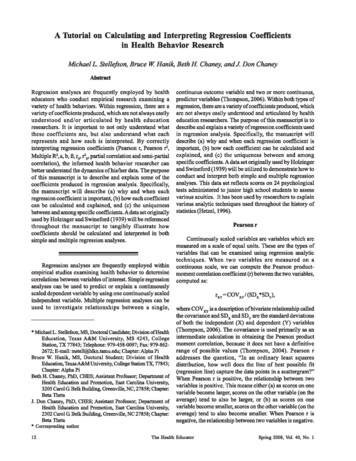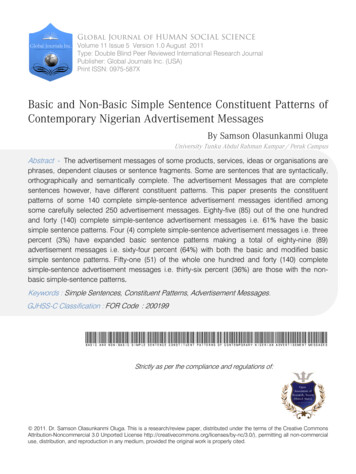
Transcription
Global Journal of HUMAN SOCIAL SCIENCEVolume 11 Issue 5 Version 1.0 August 2011Type: Double Blind Peer Reviewed International Research JournalPublisher: Global Journals Inc. (USA)Print ISSN: 0975-587XBasic and Non-Basic Simple Sentence Constituent Patterns ofContemporary Nigerian Advertisement MessagesBy Samson Olasunkanmi OlugaUniversity Tunku Abdul Rahman Kampar / Perak CampusAbstract - The advertisement messages of some products, services, ideas or organisations arephrases, dependent clauses or sentence fragments. Some are sentences that are syntactically,orthographically and semantically complete. The advertisement Messages that are completesentences however, have different constituent patterns. This paper presents the constituentpatterns of some 140 complete simple-sentence advertisement messages identified amongsome carefully selected 250 advertisement messages. Eighty-five (85) out of the one hundredand forty (140) complete simple-sentence advertisement messages i.e. 61% have the basicsimple sentence patterns. Four (4) complete simple-sentence advertisement messages i.e. threepercent (3%) have expanded basic sentence patterns making a total of eighty-nine (89)advertisement messages i.e. sixty-four percent (64%) with both the basic and modified basicsimple sentence patterns. Fifty-one (51) of the whole one hundred and forty (140) completesimple-sentence advertisement messages i.e. thirty-six percent (36%) are those with the nonbasic simple-sentence patterns.Keywords : Simple Sentences, Constituent Patterns, Advertisement Messages.GJHSS-C Classification : FOR Code : 200199Basic and Non-Basic Simple Sentence Constituent Patterns of Contemporary Nigerian Advertisement MessagesStrictly as per the compliance and regulations of: 2011. Dr. Samson Olasunkanmi Oluga. This is a research/review paper, distributed under the terms of the Creative CommonsAttribution-Noncommercial 3.0 Unported License http://creativecommons.org/licenses/by-nc/3.0/), permitting all non-commercialuse, distribution, and reproduction in any medium, provided the original work is properly cited.
Samson Olasunkanmi OlugaKeywords : Simple Sentences, Constituent Patterns,Advertisement Messages.AI.INTRODUCTIONsentence according to Ballard (2001:137) is thelargest unit of a syntactic structure which consistsof at least a main clause but which may consist ofseveral. To Radford (2009:479) as sentence is simply aterm synonymously used to refer to a root clause whichis basically a free standing clause that is not acomponent of another expression. Swan (2005:24) alsodefines a sentence as a group of words expressing astatement, command, question or an exclamation,consisting of one or more clauses, having at least asubject and a predicator and starting with a capital letterand ending with a full stop, question mark orexclamation mark especially in writing. Finch (2005:109)points out that the traditional definitions of sentencesdescribe them as grammatically complete units oflanguage capable of standing on their own andsemantically independent. This to him is true of so manysentences but not all sentences.A sentence constituent simply refers to each ofthe elements or components of a given sentence. Asimple major sentence according to Finch (2005:110111) is a complete sentence that has just a singleAuthor : Research Phd Student Faculty of Arts and Social Sciences,Faculty of Arts And Social Sciences, Universiti Tunku Abdul Rahman,Kampar / Perak Campus, Malaysia. E-mail : samoluga@yahoo.comMobile : 60165650154clause and consists of elements or components likesubject, predicator, direct object, indirect object, subjectcomplement, object complement and adverbial. Thevarious elements or components of a simple major 17sentence are usually combined in various ways to formthe different sentence constituent patterns. Aremo(2004) identifies nine basic simple sentence patternswith obligatory constituents or components which cannot be omitted or deleted without rendering thesentence incomplete. The nine basic simple-sentencepatterns are the SP, SPOd, SPOiOd, SPCs(n), SPCs(adj),SPA, SPOdCc(adj) , SPOdCo(n) and SPOdA patterns. Someof the basic simple sentence patterns can be expandedby appropriately adding some other optionaladverbial(s) to the basic patterns. The non-basic simplesentences are formed by altering the basic sentences ina number of ways as in interrogative, imperative,exclamatory and negative sentences.Advertisement according to Bearden, Ingramand La Forge (2001:393) is a marketing communicationthat is persuasive, non-personal, paid for by anidentified sponsor and disseminated through masschannels of communication to promote the adoption ofgoods, services, persons or ideas. Robin (2010) alsodefines an advertisement as a specific messageconstructed to inform, persuade, promote, provoke ormotivate members of a target audience in respect of aparticular brand or on behalf of a group. She adds that agroup in this context could be commercial isations. To Needham and Dransfield (2000),advertisement is a message or information aboutproducts, services or ideas sent through the media toinform, persuade or influence the people to receivethem. Oluga (2003:117) also defines an advertisementas a means of publicizing the activities of a given firm,business or organization with a view to making thegoods or products sold or services rendered known tothe target audience.Advertisements according to Okanlawon andOluga (2008:45) usually have verbal messages apartfrom their visual images or messages. The verbalmessages, spoken or written, are usually speciallyworded using captivating incomplete expressions likephrases, dependent clauses or sentence fragments aswell as complete sentences. The complete sentenceadvertisement messages however, have grammaticalVolume XI Issue V Version Iservices, ideas or organisations are phrases, dependentclauses or sentence fragments. Some are sentences that aresyntactically, orthographically and semantically complete. Theadvertisement Messages that are complete sentenceshowever, have different constituent patterns. This paperpresents the constituent patterns of some 140 completesimple-sentence advertisement messages identified amongsome carefully selected 250 advertisement messages. Eightyfive (85) out of the one hundred and forty (140) completesimple-sentence advertisement messages i.e. 61% have thebasic simple sentence patterns. Four (4) complete simplesentence advertisement messages i.e. three percent (3%)have expanded basic sentence patterns making a total ofeighty-nine (89) advertisement messages i.e. sixty-four percent(64%) with both the basic and modified basic simple sentencepatterns. Fifty-one (51) of the whole one hundred and forty(140) complete simple-sentence advertisement messages i.e.thirty-six percent (36%) are those with the non-basic simplesentence patterns.Global Journal of Human Social ScienceAbstract - The advertisement messages of some products,August 2011Basic and Non-Basic Simple SentenceConstituent Patterns of Contemporary NigerianAdvertisement Messages 2011 Global Journals Inc. (US)
August 2011Basic and Non-Basic Simple Sentence Constituent Patterns of Contemporary NigerianAdvertisement MessagesGlobal Journal of Human Social ScienceVolume XI Issue V Version I18elements or constituents with different combinations orpatterns. Some complete advertisement messages havethe basic sentence constituent patterns whosecomponents or elements are obligatory and cannot t messages have non basic sentenceconstituent patterns achieved via the alteration of any ofthe basic sentence patterns.II.METHODOLOGY OF STUDYThe advertisement messages of two hundredand fifty (250) products, services, ideas or organizationswere gathered from various newspaper advertisements,poster advertisements, handbill advertisements andbillboard advertisements. The selection was however,carefully done to ensure the inclusion of differentcategories of products, services, ideas or organisations.Hence, we have the advertisement messages of drugs,alcoholic and non alcoholic drinks, vehicles, toiletries,banks/banking services, insurance firms/services,telecommunications firms/services, Nigerian Police,Federal Road Safety Commission (FRSC) andEconomic and Financial Crime Commission (EFCC) etc.Some few organisations that constantly advertise theirproducts have more than one advert message but notmore than three messages for a single product ororganisation. Out of the two hundred and fifty (250)advertisement messages, only one hundred and forty(140) i.e. 56% are complete simple-sentenceadvertisement messages used for the purpose of thisstudy. These advertisement messages were thensubjected to syntactic observation/examination todetermine their constituent patterns.III.ANALYSIS OF FINDINGSThe analysis of the constituent patterns of isement messages will be in three phases. Thefirst will analyse the advertisement messages that fallwithin the nine basic sentence patterns, the second willanalyse the expanded basic simple-sentence patternsbuilt on the nine basic simple-sentence patterns whilethe third will analyse other advertisement messages thatconstitute the non-basic simple sentences that are notdirectly built on the nine basic simple sentence patterns.The simple percentage will be used to determine thenumerical representation of each of the various patternswithin and outside the basic simple-sentence category.The percentages of the two major categories will bedetermined to show whether the patterns of thecomplete sentence Nigerian advertisement messagesare in line with the basic simple-sentence patterns or thenon-basic simple-sentence patterns. The capitalalphabet ‘S’ is used to represent the Subject of asentence, ‘P’ for the Predicator, ‘C’ for the Complement,‘O’ for the Object and ‘A’ for the Adverbial. When wehave two objects, ‘Oi’ stands for the Indirect Object 2011 Global Journals Inc. (US)while ‘Od’ stands for the Direct Object. The SubjectComplement is also differentiated from the ObjectComplement as ‘Cs’ stands for Subject Complementand ‘Co’ stands for object complement.IV.THE BASIC SIMPLE-SENTENCEPATTERNS OF ADVERTISEMENTMESSAGESThere are nine basic simple-sentence patternsas earlier mentioned whose constituents are compulsorycomponents or elements to have complete sentences.There are five out of the nine basic patterns among theone hundred and forty syntactically analysed completesentence advertisement messages. The total numbersof the advertisement messages with the basic simplesentence patterns are eighty-nine (89), including theexpanded patterns, which represents sixty-one percent(61%). The five basic sentence patterns are the SPO,SPC, SPA, SPOA, and SP. It is important to note that thesubject of the sentence can be a noun, a noun phrase, anoun clause or a pronoun. The predicator of thesentence can be a verb, a verb phrase or a phrasalverb. The complement (subject/object) can be nominali.e. a noun, a noun phrase or noun clause, a pronoun orit can be adjectival i.e. an adjective, adjectival phrase oradjectival clause. The object can be direct or indirect.The adverbial can be an adverb (adjunct/disjunct), anadverbial phrase or an adverbial clause.a) The SPO Advert Message Sentence PatternThis is the first basic sentence pattern identifiedamong the one hundred and forty complete simplesentence advertisement messages. The advertmessages with this pattern have sentences with thecombination Subject plus Predicator plus Object i.e.(SPOd). Twenty-eight (28) out of the one hundredand forty (140) complete sentence advertisementmessages i.e. 20% have this pattern as shown below:likeit1. Coast Milk WeSPO2. Hyundai Azera We give the chance to experience A-Z ofluxurySPO3. DHL1 We have got the connectionsPOS4. Intercontinental Bank We make the differenceSPO5. Bitter Apperito You will love the tasteOSP6. Cowbell Chocolate It has got it (NB: It’s It has)SPO7. Klin Detergent So little gives so muchSPO8. Quincy Herbal Slimmers We have access to natureS PO9. Lady care Lady takes care of your period . (NB:‘ur’ your)OSP
b)The SPC Advert Message Sentence PatternThis is the second basic sentence patternidentified among the one-hundred and forty completesentence advertisement messages. Thirty-six (36) out ofthe one hundred and forty (140) complete sentenceadvertisement messages i.e. 26% have this pattern. Thismeans the sentences of the advertisement messageshave the combination Subject plus Predicator plusComplement i.e. (SPC) pattern as indicated below:29. Skoda Octavia The best decision are those you enjoy.SPC30. Pension Trust Fund Pension is all about trustSPC31. Legend It is your lifeS PC32. Seven (7) Up The difference is clearPCS19Volume XI Issue V Version I33. SACA AIDS is real.P CS34. L.G. Life is goodCSP35. Sagem Myx7 It is an experience (It’s it is)S PC36. Knorr Cube Every meal is a storySPC37. Interswitch Life is simpleCS P38. Thermocool The choice is yours.PCS39. Gillette Blue 2 Two is better than one.CS P40. Maggi cube Taste is everything.PCS41. MTN1 Life is beautiful.S PC42. Chevrolet Envy is inevitable.PCS43. Hi Malt I feel good.S P C44. IBTC Your Pension is your future.CSP45. Pincanto Kia Life is more beautiful.SPC46. Child Care Trust It could have been you.PCS47. First Inland Bank You are welcome.PCS48. Epson Printers What you put in is what you get out.SPC49. Sovereign Trust Insurance All our policy is to brightenSPCyour life.50. Dangote Cement Dangote is what everybody now uses.PCS51. Volkswagen Passat It is love at first sight.S PC52. Top Lait Milk That is my milk.PCS53. Vono Foam Great comfort is our promise.SPC54. Stanbic IBTC Our door isopen.SPC55. Nigerian Police Police is your friend.S PC56. Total Oil Our energy is your energy.CSP57. Super Master1 Our name is guarantee of originality.SPC58. Eskimo Cooler It is the coolest one.CS P59. Thermolineo Food Flask It is the right choice.S PC60. Super Master2 God is the Supermaster.PCSGlobal Journal of Human Social Science10. Benylin You can trust BenvlinPOS11. Canon Printers & Copiers We have the solutionSPO12. Starcoms We speak your languageSPO13. DHL2 We move the worldPOS14. Carat Soap Your skin deserves the bestPOS15. Mattew Worm Elixir You have got one thing to loseSPO16. Funman Juice We have got the quality.(We’ve we have)SPO17. Climax Hotel A sincere reception awaits youPOS18. Stallion Rice We serve the nationSPO19. Ovaltine Malt makes the differencePOS20. IGNIS Your wife is having an affair.POS21. Fidson Health Care We value life.POS22. Full-Tox paint Quality tells the differencePOS23. Macmillan Reading makes a man.SPO24. Harp I like a beer that has nothing to hide.S PO25. Mutual Assurance Plc We keep our promises.SPO26. Bournvita Every child deserves BournvitaOPS27. Unity Bank Success story awaits youPOS28. Bank PHB Everybody loves ahappy endingSPOAugust 2011Basic and Non-Basic Simple Sentence Constituent Patterns of Contemporary NigerianAdvertisement Messages 2011 Global Journals Inc. (US)
August 2011Basic and Non-Basic Simple Sentence Constituent Patterns of Contemporary NigerianAdvertisement Messages61. Lotto Nigeria Everyone is a winner.SPC62. Lafia Hotels Privacy is our strength.PCS63. Globe Motors Life is a journey.SPC64. Coca Cola Life tastes good.PCSc)The SPA Advert Message Sentence PatternGlobal Journal of Human Social ScienceVolume XI Issue V Version IThis is the third basic simple-sentence patterns.identified among the one hundred and forty (140)complete simple - sentence advertisement messageThere are just ten (10) advertisement messages out of20 one hundred and forty (140) complete simple-sentenceadvertisement messages which represent just 7%. Thesentences of these advertisement messages have thecombination Subject plus Predicator plus Adverbiali.e.(SPA) pattern as illustrated below:65. Diamond Bank1 Welcome ideas come in mini packages.SPA66. Macleans1 The mac of fresh confidence is back.SP A67. Mercury Cameras Memories are forever.SPA68. Listerine The world number one is here.SP A69. Diamond Bank1 Diamonds are forever.SPA70. EFCC Nobody is above the law.SPA71.Wema Bank Great things happen when we talk together.SPA72. Peak Milk It is in you. (It’s it is)AS P73. Guinness Stout Actions speak louder than words.SPA74. Omo Detergent It washes brighter than it shows.SPA75. Investment and Allied Assurance We are by your sideS PAd) The SPOA Advert Message Sentence PatternThis is the fourth basic sentence pattern ofsome of the complete sentence advertisementmessages syntactically examined. The advertisementmessages whose sentences falls within this categoryhave the combination obligatory Subject plus Predicatorplus Object plus Adverbial i.e.(SPOiA) pattern. There areeight (08) advertisement message sentences out of theone hundred and forty (140) i.e. 6% with this pattern asenumerated below:76. Tastee Fried Chicken We do chicken right.S POA77. Siemens2 We touch lives in many ways.POSA78. IGI Insurance We pay a genuine claim promptly.OAS P 2011 Global Journals Inc. (US)79. Macleans2 I have got my confidence back (I’ve I have)SOAP80. Union Bank We have struck Nigeria with just a click.(We’ve We have) SPOA81. DHL3 No one knows Europe like we do.POAS82. Dunlop Nothing profiles you better.SPOA83. Crusader We give security and comfort in retirement .OAS Pe) A The SP Advert Message Sentence PatternThis is the fifth basic sentence pattern whichsome three (3) complete sentence advertisementmessages follow and this number represents just 2% ofthe total one hundred and forty (140) complete isement messages with this pattern have just twoobligatory components or elements which are thesubject and the predicator i.e. the S P combination orpattern as shown below:84. Tetmosol It works.PS85. FRSC Speed kills.SP86. Zain Our future is blossoming.SPV.EXPANDED BASIC ADVERT MESSAGESENTENCE PATTERNSThere are four (4) advertisement messages withfour (4) other expanded basic sentence advertisementmessage patterns namely the SPAA, SPCA, ASPO andASP. These four patterns of advertisement messagesare mere modification or expansion of the alreadydiscussed SPA, SPC, SPO and SP basic simplesentence patterns. However, there is the addition of anoptional adverbial to the obligatory elements orconstituents of the sentences with these basic sentencepatterns. The four (4) out of the one hundred and forty(140) represent 3% while each of the four represent0.7% of the total complete sentence advert messages.Below are the advertisement messages with the fourpatterns:87. Premier Hotels We are with you through life.S PAA88. Dana Motors Life is more beautiful with Picanto.S PCA89. Nigeria Police Together, we fight crime.ASPO90. Etisalat1 Now, you are talking.ASPVI.THE NON-BASIC ADVERTISEMENTMESSAGE SENTENCE PATTERNSThese unlike the basic advertisement messagesentence patterns are not the constituent patterns ofpositive declarative sentences or statements. Rather,
Basic and Non-Basic Simple Sentence Constituent Patterns of Contemporary NigerianAdvertisement MessagesThis is the first non-basic sentence pattern ofthe syntactically examined contemporary Nigerianadvertisement messages. The advertisement messageswith this pattern are thirty-three (33) i.e. 24% of the onehundred and forty (140) examined in the study. They areimperative sentences that implore or request theadvertisement target audience to take certain steps ordo certain things. The subjects of these sentences arenot expressly stated but they are understood hence,only the predicators and the objects are obvious as inthe following advert messages:91. Sprite Obey your thirstPO92. Mountain Dew Do the dewPO93. MTel Talk the talkPO94. Global Technical Careers Make a differencePO95. Nescafe Taste the other side of coffeeOPShare the fun96. Fanta PO97. Lipton Tea Create your stylePO98. Mirinda Get a great tastePO99. Fanafrik Settle for cool breezePO100. Guinness Extra Stout Discover the smoothnessPO101. Jumbo soap Show your colourPO102. Power Horse Free your energyPO103. Calypso Cream Ignite your passionPO104. Jik Fight stains that detergent alone cannot removeOP105. Gold Spot Feel the excitementPO106. Qlink Iron Enjoy the Qlink newest household dry ironPOb) The P. C. Advert Message Sentence PatternThe advertisement messages with Predicatorplus Complement sentence pattern are just four (4) innumber i.e. 3% of the total one hundred and forty (140)complete sentence advertisement messages.The sentences with this pattern also haveimplied or understood subjects that are not stated ormentioned. Below are the advertisement messageswhose sentences fall within this category:124. Amstel Malta Be renewedCP125. Siemens MC60 Be inspiredPC126. Dettol1 Be absolutely surePC127. Baby Pear Be what you arePCAugust 2011Get natural tasteOP108. Peugeot 307 Redeem your imagePO109. MTN2 Achieve what you can achievePO110. Nigerian Supporters Association (NSA) Go for goalPO111. MTN3 (Super Booster) Boost your profit.PO112. Gordon Spark Spark up your lifePO113. Delta Soap Upgrade your skinPO114. Imperial Leather Experience the luxuryPO115. Star Beer Share the brighter lifePO116. Maggi Enjoy your cookingOP117. Mirinda2 Taste the thrillPO118. New Legend Carry da torch (da the)PO119. Etisalat2 Enjoy home advantagePO120. Glo Follow the leaderPO121. Tom Tom Clear the airwaysPO122. Caleb University Fulfil your dreamsPO123. Samsung Capture memories of brilliant momentsPO21Volume XI Issue V Version Ia) The PO Advert Message Sentence Pattern107. Vedan Global Journal of Human Social Sciencethey can be other forms of sentences like the imperative,interrogative and exclamatory sentences as well as thenegative forms of the declarative sentences. However,the non-basic advertisement messages identifiedamong the one-hundred and forty (140) completesentence advertisement messages are mainly theimperative and some exclamatory sentences. They arefifty-one (51) all together which represent 36% of thetotal complete sentence advertisement messages. Theyhave four different patterns which are the PO, PC, PAand POA sentence constituent patterns.c) The P A Advert Message Sentence PatternamongThere are three (3) advertisement messagesthe one-hundred and forty syntactically 2011 Global Journals Inc. (US)
August 2011Basic and Non-Basic Simple Sentence Constituent Patterns of Contemporary NigerianAdvertisement Messagesexamined that fall within the Predicator plus Adverbialsentence patterns which represents just 2%. Thesentences also do not have expressly mentionedsubjects as illustrated in the following:128.Krest Stand up from the crowdAP129. NBA African Scholarship Go where ambition takes youPA130.Multivite Go extra milePAd) The P O A Advert Message Sentence PatternGlobal Journal of Human Social ScienceVolume XI Issue V Version I(10) complete - sentenceWe have tenadvertisement messages out of the one hundred and22 forty (140) advertisement messages i.e. seven percent(7%) that have the Predicator plus Object plus rtisement messages just like others with the nonbasic sentence patterns do not have stated subjects ascan be seen in the following:131. Samsung L700 Set the bar highPOA132. Michelin Have a safe journey with MichelinPOA133. Trophy Get your bearing rightPOA134. Seaman’s Schnapps Don’t offend our ancestors withfake winePAO135. DSTV Bring the world into your living roomPOA136. Jik Jik it upP O A137. Bacchus Tonic Wine Celebrate life everydayPOA138. Dansa Juice Juice it upPO A2139. Dettol Protect your skin from germsPOA140. Flourish Tooth Paste Express it with flourish gelPOAVII.References References Referencias1.Aremo, B. (2004): An Introduction to EnglishSentences (I & II). Ibadan: Scribo Pub. Ltd.2.Ballard, K. (2001): The Frameworks of English.New York: Palgrave.3.Bearden, W. O., Ingram, T. N. & La Forge R. W.(2001): Marketing: Principles and Perspectives.Boston: McGraw Hill Irwin.4.Finch, G. (2005): Key Concepts in Languageand Linguistics. New York: Palgrave.5.Needham D. & Dransfield K. (2000): AdvancedBusiness. Oxford: Heinemann EducationalPublishers.6.Okanlawon, B. O. & Oluga, S. O. (2008):“ExaminationofLanguageUseinContemporary Nigerian Advertisement CopyMessages”. Marang - Journal of Language andLiterature. 18(1), 37-48.7.Oluga, S. O. (2003): “Ambiguity and Languageof Advertisement via the Mass Media andRelated Cleans: The Need for ProperDisambiguation”. Multidisciplinary Journal ofResearch Development 2(2), 1 17 – 123.8.Radford, A. (2009): Analysing EnglishSentences: A Minimalist Approach. Cambridge:Cambridge University Press.9.Robin (2010): Advertising: Generating andDesigning Ideas across Media. Hoboken, NJ:John Wiley & Sons Inc.CONCLUSIONIt is crystal clear from the analyses of theconstituent patterns of the one hundred and forty (140)complete-sentence advertisement messages identifiedfrom the total of two hundred and fifty carefully selectedthat most of the advertisement messages consideredhave the basic simple-sentence patterns. This isbecause eighty five (85) of the complete-sentenceadvertisement messages i.e. 61% have the basicsimple-sentence patterns SPO (28 in number i.e. 20%),SPC (36 in number i.e. 26%), SPA (10 in number i.e.7%), SPOA (8 in number i.e. 6%) and SP (3 in numberi.e. 2%). Four (4) other advertisement messages out ofthe total one- hundred and forty have one each of themodified or expanded basic simple-sentence patternsSPAA, SPCA, ASPO and ASP. This means those with 2011 Global Journals Inc. (US)both the basic and modified basic simple-sentencepatterns are eighty-nine (89) in number which represent64% of the one hundred and forty (140) completesentence advertisement messages.Thecompletesentenceadvertisementmessages with the non-basic sentence patternsconstitute the remaining fifty-one (51) advertisementmessages which represent 36% of the entire onehundred and forty complete sentence advertisementmessages. Four (4) non-basic sentence patterns wereidentified namely the PO, PC, PA and POA patterns. Theadvertisement messages with the Predicator plus Objectpattern are thirty three (33) i.e. 24% of the one hundredand forty (140). Those with the Predicator plusComplement pattern are just four (4) i.e. 3% of the onehundred and forty (140). Those with the Predicator plusAdverbial pattern are three (3) i.e. 2% of the onehundred and forty (140) while those with the Predicatorplus Object plus Adverbial pattern are ten (10) i.e. 7% ofthe entire one hundred and forty complete-sentenceadvertisement messages.10. Swan, M. (2005): Practical English Usage.Oxford: Oxford University Press.
built on the nine basic simple-sentence patterns while the third will analyse other advertisement messages that constitute the non-basic simple sentences that are not directly built on the nine basic simple sentence patterns. The simple percentage will be used to determine the numerical representation of each of the various patterns

